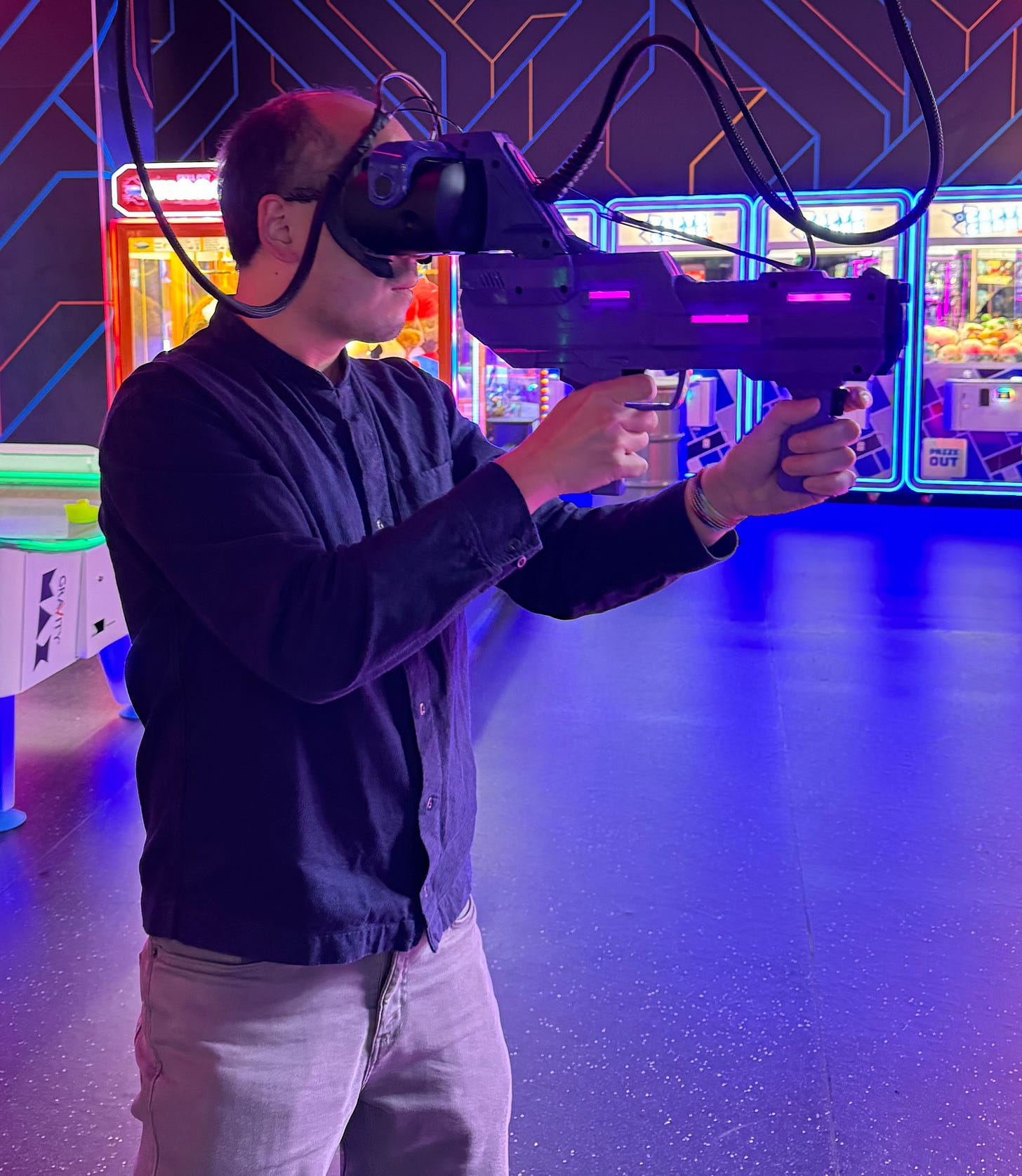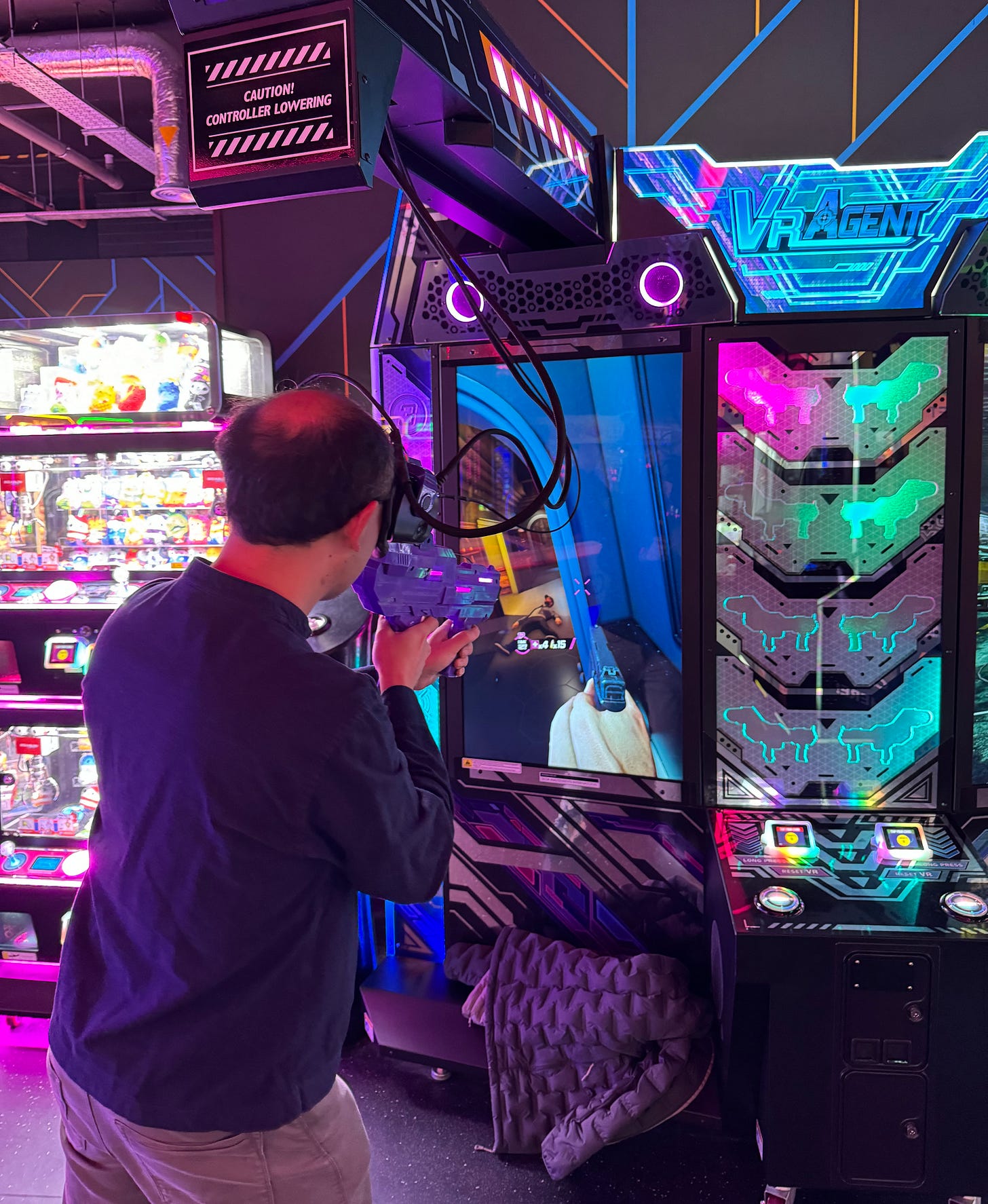£1.20 per play ($1.50)
5 minutes long
VR Agent is a rail shooter arcade game where you automatically proceed along a fixed route, shooting enemies and dodging as they shoot back.
While the game has a screen, it’s only for onlookers – the player looks through a VR headset that’s fused to a toy gun. After you pay, the whole apparatus automatically descends on wires from its secure storage in the top of the unit, making it unusually “attendant free”, unlike other arcade VR games that require someone to help you put the headset on.
I’ll be honest: the game isn’t much to write home about. I’ll describe it shortly, but what drew me to this game was its hardware. I have never seen a VR experience like this and it makes me wonder whether we shouldn’t try bolting VR headsets onto other things.
Despite its unique design, holding the gun and bringing my eyes to the headset felt comfortable and natural. There was no way to adjust the eyepieces’ separation to account for interpupillary distance as most consumer VR headsets, but a little shuffling of the gun made the view decent enough; as good as any public VR headset I’ve used, at least.
I didn’t feel encumbered by the headset, probably because it wasn’t weighing down on my head; instead, my arms were carrying everything. Nor did I feel much motion sickness as the game slowly moved me along a set path, with only one exception at the start of the second level when I improbably floated down from a platform to the ground. In other words, despite VR Agent offering an entirely new control and display mechanism, it worked perfectly well.
The gun had two triggers: one to fire and the other to reload. This is different from most light gun arcade games which have a single trigger, where you fire away from the screen to reload. Of course, this can’t work in VR Agent since there is no screen. Because your view is fixed “above” the gun, you can’t sight down the barrel either; most players don’t do this in arcade games, but it still made it hard for me to know where I was shooting. Instead, the game displayed a reticle where my gun was pointing, which was just about OK.
The game itself is very normal rail shooter stuff: I was taken through offices and corridors, pausing at locations to clear out enemies who’d pop out behind desks and around corners. All enemies had a health bar that’s chipped away when you shoot them, with damage numbers flying out of them; as usual, headshots kill most enemies instantly. Some enemies carry shields, requiring you to hit a series of weak points before they can be taken down.
You can avoid incoming fire by moving physically behind walls (presumably it’s just the headset position that’s being tracked), though in practice the game didn’t effectively telegraph the direction enemies were shooting me from, so it was more of a Time Crisis-style "duck to avoid all fire” rather than the directional dodging in Police 911 (aka Police 24/7), which used a series of infrared sensors to detect your body position. Perhaps this is because they don’t want players to break the headset or hurt themselves; regardless, it made the game a lot less fun.
Something I didn’t realise until I watched a couple of kids play was the extent to which the game makes you spin around. One kid was turning a full 180 degrees from their left to right to hit enemies on all sides. Weirdly, I never felt like I was moving that much when I was playing, even though I absolutely was. I can only assume this misconception is due to the tight corridors, and that turning isn’t the same as walking.
Ultimately, VR Agent is more of a well-executed tech demo than an actual game; given that it’s one of Sega’s first VR arcade games, that seems understandable. VR in public has always struck me as impractical since it costs so much to have attendants on hand at all times, but this game demonstrates how VR experiences can be cheap, easy, and quick.
They’re still working on “good”, though. What VR Agent boasts in immersion and convenience, it lacks in depth and challenge. I much prefer Police 911 or Silent Scope, an arcade game where the light gun has a little “sniper display”. Most of the time you’re looking through it to pick off distant enemies, but since its field of view is so narrow, sometimes you need to look up at the main arcade screen to find your next target or to spray incoming helicopters with bullets. The constant tension of deciding which screen to use makes it a game with meaningful choices and skill – unlike VR Agent.
I played VR Agent, along with last week’s Squid Game Immersive Gamebox, at Gravity Max Liverpool, a big venue that opened this summer featuring “competitive socialising” and “immersive entertainment” in the form of the latest arcade games, multiplayer VR areas, augmented reality darts and bowling, and a multi-level karting track. As traditional shops and malls are placed by online retail, they’re increasingly being replaced by indoor entertainment complexes that offer a kind of fun that can’t be delivered via traditional video games.
No-one should expect a resurgence of arcades to their pre-console era, but I do think these complexes are replacing other kinds of socialisation and recreation. Instead of kicking around a football in parks that no longer exist or playing darts in a pub that feels unwelcoming, people choose – or are limited to – these more polished, more expensive, more predictable experiences. That they’re climate-controlled merely adds to the vaguely dystopian feel.
Ultra Moto VR was one of a few other VR games at Gravity Max, this one costing £3.50 per play ($4.50). When you put the headset on, it asks what level of motion you’re comfortable with. I opted for maximum immersion, which I assume means I got the VR headset’s full field of view during racing rather than a limited “comfort blinders” view. It also meant I endured an unnecessarily nauseous pre-race sequence where you zoom through the air towards your waiting motorbike.
The game is pretty standard stuff and I was a bit disappointed the motorbike seat didn’t move itself; instead, I moved it to steer. Despite that, the immersion was impressive and I could see myself trying an improved version with better graphics and gameplay .
Like VR Agent, Ultra Moto VR is attendant free. The headset is attached by a thick wire to the motorbike, and when not in use, sits in a receptacle in the front. None of the players I watched had any difficulty in wearing it, which goes to show how pervasive VR has become. The fact that none of the VR games at Gravity Max were broken also demonstrates that current-generation headsets can withstand a lot of punishment – plus they aren’t unusual enough to be targets for vandalism any more. Even then, the game’s headsets – 3Glasses Blubur S2 – only cost $549 to replace.
VR isn’t suitable for a lot of arcade games and it’s still not very social, which is kind of the point of an arcade; in VR you can’t turn to high five a friend or see if they’re having fun. But manufacturers and operators and players seem happy enough, so I’m very interested to see what the next wave will look like.








